Do Brits need to toughen up in a heatwave?
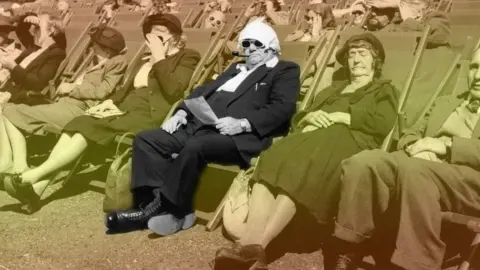 Getty Images
Getty ImagesWhy do Britons find it so hard to cope in a heatwave?
With scientists saying that the late June heatwave in Europe was made "at least five times" more likely because of climate change, do us Brits just need to toughen up? Or is there a reason we seem to feel the heat so much?
The definition of a heatwave varies depending on where you are.
The World Meteorological Organization defines it as "a period of more than five consecutive days where the daily maximum temperature exceeds the average maximum temperature by 5C or more".
So, while five days of 30C or more is a heatwave in the UK, in India temperatures may have to climb to a sweltering 40C to earn the same title.
Nigel Taylor, a former associate professor at Australia's University of Wollongong, says the human body is very good at adapting to changing temperatures, because we have to keep our bodies within a 4C range to prevent hypothermia and hyperthermia.
"It was because of that ability, along with our ingenuity, that we were able to leave Africa and emigrate to a wide range of climates," he explains.
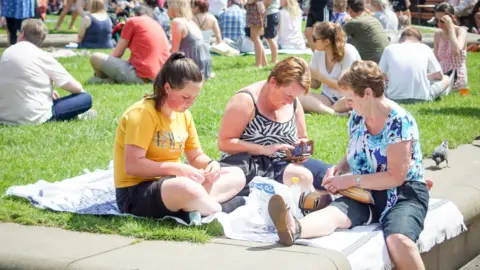 Getty Images
Getty ImagesHowever, he says it does not happen overnight and adds: "The longer we are exposed to an elevated body temperature, the faster we will adapt. Some improvements occur in a few days, but others take longer and even years to occur."
A series of biological changes - called thermal adaptation - enable us to cope with that change.
In dry heat, when humidity is low, the evaporation of sweat from the skin cools the body. This is a normal reaction, and not a form of thermal adaptation.
However, Mr Taylor explains that the way and amount we sweat will depend on how regularly we are exposed to extreme high temperatures.
"In the heat, we initially sweat rather profusely, but we eventually learn to sweat more efficiently. This means less sweat, but with greater evaporation, so we dehydrate less quickly," he says.

Some forms of thermal adaptation:
- Sweating becomes more efficient
- Reduced salt loss through sweat and urine
- The body conserves water, reducing thirst
- Heart rate is reduced
- Skin flushes more as blood comes to the surface

Mr Taylor warns that while we have a remarkable ability to acclimatise, our modern lifestyles mean "we rarely get the chance to adapt to the heat. We have removed the need, or opportunity, to adapt".
"So a businessman from Mumbai who lives in an air-conditioned home, travels to work in an air-conditioned vehicle and works in an air-conditioned office, will have the same level of thermal adaptation as a relative with the same lifestyle living in London," he says. "Another analogy; we do not become Olympians by watching events on TV."
The air conditioning revolution
Modern air conditioning has fundamentally changed the way many people around the world experience extreme heat.
It is a magic bullet for some, but it is rarely an option for wilting Brits.
Only around 3% of homes in the UK have air conditioning, far fewer than other countries. So, while summer temperatures in Australia or the US may exceed those in the UK, the actual conditions inside the home are likely to be significantly more comfortable.
While the cost of installing an AC system may have fallen since its invention in the 1920s, for many people living in consistently hot countries it is still prohibitively expensive.
Of the 2.8 billion people living in the hottest parts of the world, only 8% currently possess air conditioning, according to the International Energy Agency.
Local knowledge
So, if our homes are not air conditioned, are they at least designed to keep us cool during a heatwave?
Unfortunately, modern homes in the UK are designed to do quite the reverse.
Architect and author Sandra Piesik researches traditional building styles and says they can keep inhabitants comfortable in hot weather, because they are based on local knowledge and materials.
For example, homes made with thick mud walls, such as those in Taos Pueblo in New Mexico, are a feature of many traditional communities in very hot areas.
They have a high thermal mass, meaning they absorb and store the sun's energy in the day and release it at night when it is cooler.
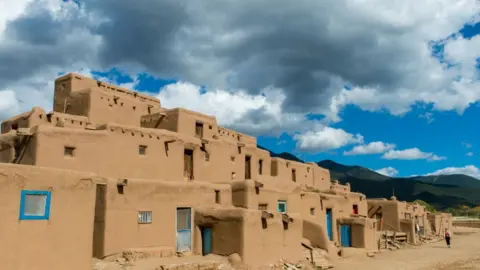 Getty Images
Getty ImagesOn a larger scale, there are examples of whole cities made in this way.
"Buildings are closely packed together to create shade," says Ms Piesik, who also advises the UN on sustainable urban planning.
"They are orientated in a very specific way to capture wind and shield people from the sun most effectively,"
Many of these buildings have small windows to limit how far the sun reaches inside. But in the UK many are designed to maximise the amount of sunlight that streams in, especially during our longer winters.
The Algerian city of Ghardaia in the scorching Sahara Desert is a classic example of a city built from earth.
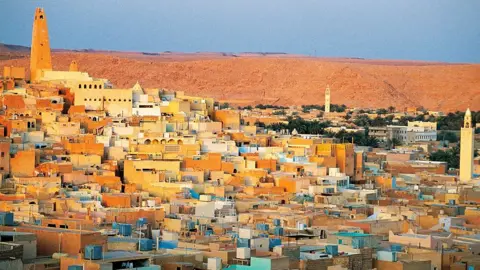 Getty Images
Getty ImagesAll about eaves
Ms Piesik says simple design features, not commonly seen in the UK, can help keep homes cooler.
"Overhanging eaves on the outside of buildings are common in many tropical areas and the southern states of America. They help shade the home from the sun.
"External window covers like shutters and shaded internal courtyards also help to keep homes cool."
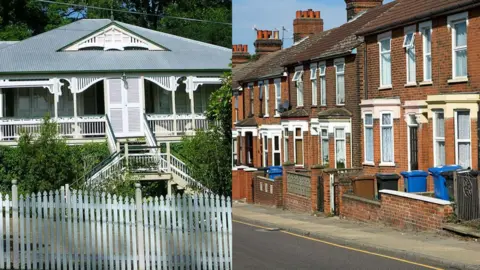 Getty Images
Getty ImagesThe Pearl Academy of Fashion in Jaipur, India is a great example of how traditional cooling techniques and modern building styles have been combined.
Architect Manit Rastogi used traditional stepwells to provide respite from the beating heat of Rajasthan.
They are simply wells which you access by steps down from street level.
The evaporation of water from the sunken pools reduces the temperature in the surrounding area and increases humidity in dry heat.
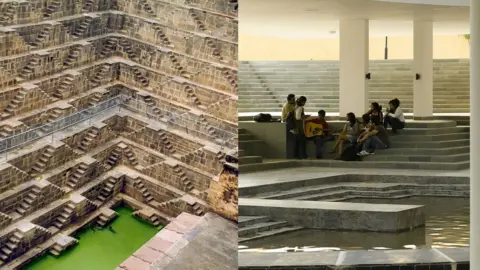 Getty Images
Getty ImagesBut, while the odds may be stacked against us Britons during a heatwave, do not despair.
After all, our bodies and homes are not adapted to the heat for one simple reason - they do not really need to be.
While we may struggle through extreme heat for a few days, rest assured it will probably not be long before we are back to the comfort of a mild British summer.

Do you have any questions about the legal restrictions around what you can and can't do when the temperature soars? Let us know and a selection will be answered by a BBC journalist.
Use this form to ask your question:
If you are reading this page on the BBC News app, you will need to visit the mobile version of the BBC website to submit your question on this topic.
